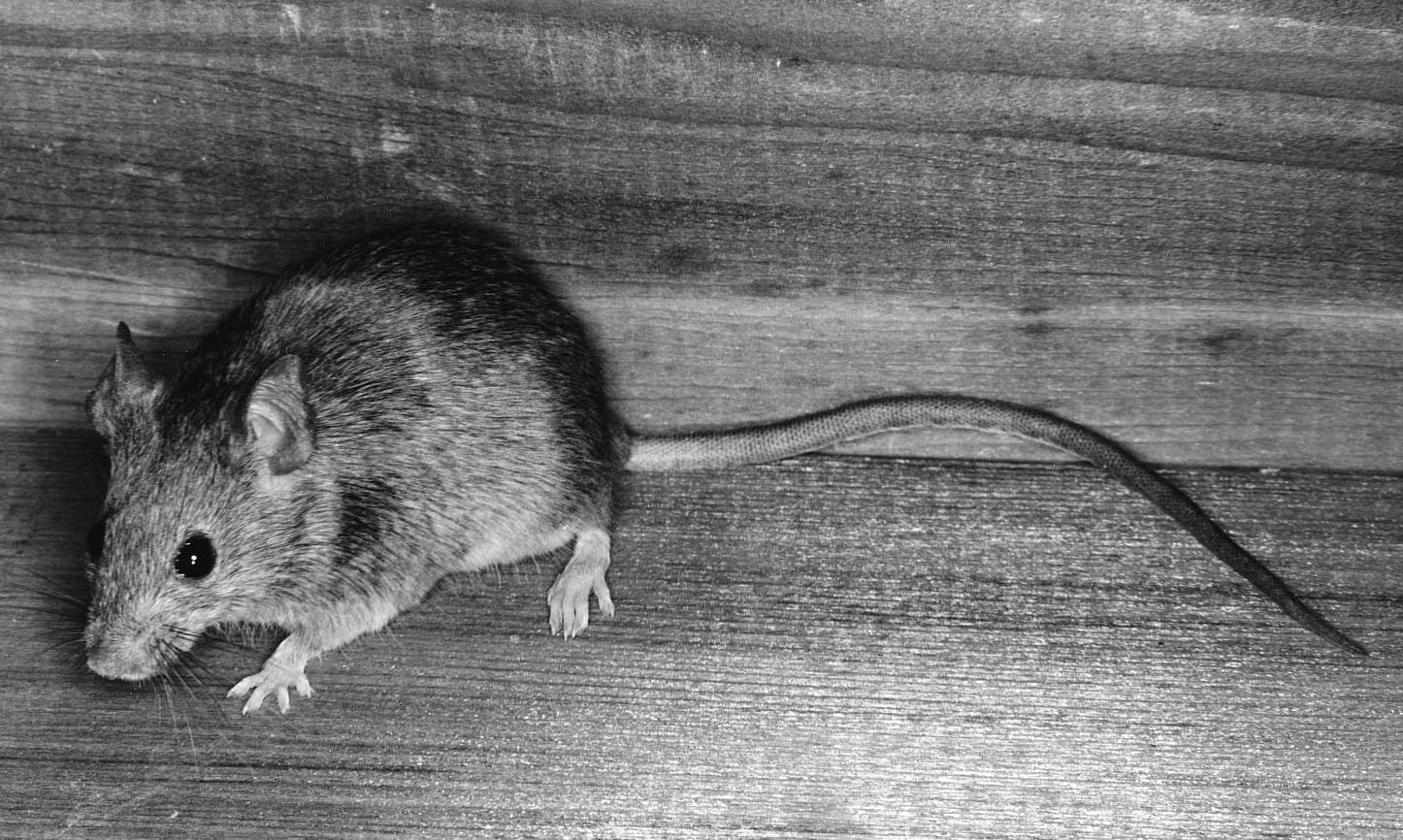HOUSE MOUSE*
Mus musculus Linnaeus 1758
Order Rodentia : Family Muridae
*Introduced species
DESCRIPTION. A small, scaly-tailed mouse with a distinct notch in the cutting surface of upper incisors (seen best in side view); hair short; ears moderately large and naked; upperparts ochraceous, suffused with black; belly buffy white or buffy, usually without speckling and with slaty underfur; yellowish flank line usually present; tail brownish with black tip, not distinctly bicolor, but paler on underside; ears pale brown, feet drab or buffy, tips of toes white. Mammae in four or five pairs. Averages for external measurements: total length, 169 mm; tail, 93 mm; hind foot, 18 mm. Weight of adults, 17–25 g.

DISTRIBUTION. Widely distributed over Texas, usually in close association with humans.
HABITS. Although not native to North America, the house mouse, since its early accidental introduction at most of our seaport towns, has become widespread and occurs either as a commensal or feral animal in practically all parts of the United States. As commensal animals, house mice live in close association with humans, in our houses, outbuildings, stores, and other structures. Where conditions permit, they may be found in fields, along watercourses, and in other places where vegetation is dense enough to afford concealment. These animals make runways through the grass similar to those of Microtus or Baiomys, or they may utilize runways made by cotton rats and other meadow-inhabiting species. In agricultural regions, where irrigation is practiced, house mice often are found in the vegetation along irrigation ditches, sometimes sharing common runways with native mice. Along the Rio Grande in Texas, patches of cane often are honeycombed with the runways of these mice. At one locality along this river, several hundred trap-nights yielded only house mice, which suggested that these animals had evicted the native mice from the area.
Although largely nocturnal, house mice are moderately active during the day, chiefly in their quest for food. In the wild, they feed on a variety of plant material, including seeds, green stems, and leaves. Alfalfa hay, either in shocks or in stacks, affords an ideal source of food supply, and consequently it is frequently infested with these mice. As commensals, house mice feed on practically any type of food suitable for the use of humans or beast. They are particularly obnoxious around granaries, feed houses, and stores and may do considerable damage in destroying or contaminating food supplies intended for human consumption. In addition, they will feed on such animal matter as insects and meat when available.
These mice are exceedingly prolific breeders; as many as 13 litters can be produced in 1 year. The number of young per litter averages about six. The gestation period is approximately 19 days, varying from 18 to 20. At birth, the young are nearly naked, with their eyes and ears closed. They develop rapidly; at the age of 3 weeks they are fully weaned, and at 4 weeks some of the young females are ready to assume family duties, although the average age of sexual maturity is about 35 days in females and 60 days in males. With commensals, breeding occurs throughout the year, although it is somewhat curtailed in the colder months. In the wild state, breeding appears to be restricted to the period from early June to late fall.
Although these mice are destructive, they are widely used in laboratories as subjects for biological, genetic, and medical studies. When ranging free, however, they do a considerable amount of damage, although they are not nearly so troublesome as the introduced rat. They can be controlled in houses relatively easily with snap traps.
POPULATION STATUS. Introduced, common. These introduced, commensal rodents live in close association with humans and their structures, but they also have become established over much of the state in abandoned fields, fencerows, weedy roadsides, and cultivated fields where they may live side by side with various species of native rodents. House mice do compete with and can replace native species, and like other introduced species they can cause serious conservation problems if they get out of control.
CONSERVATION STATUS. The IUCN lists the house mouse as a species of least concern, and it does not appear on any federal or state list of concerned species. No conservation is needed.
From The Mammals of Texas, Seventh Edition by David J. Schmidly and Robert D. Bradley, copyright © 1994, 2004, 2016. Courtesy of the University of Texas Press.
Natural Science Research Laboratory
-
Address
Museum of Texas Tech University, 3301 4th street, Lubbock, TX 79409 -
Phone
806.742.2486 -
Email
nsrl.museum@ttu.edu

